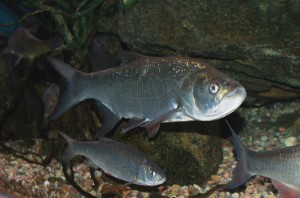 Asps are spread in Northern Europe (North and BalticSeas’ basin), and in the basins of the Black, Caspian and AralSeas. It is a secondary commercial fish in the Pskov-PeipsiLake.
Asps are spread in Northern Europe (North and BalticSeas’ basin), and in the basins of the Black, Caspian and AralSeas. It is a secondary commercial fish in the Pskov-PeipsiLake.
Commonly, asps inhabit plain rivers, sometimes lakes, and remain part of fish-fauna of larger water reservoirs with regulated rivers. In rivers asps prey on various fish – mainly bleaks. While feeding intensively, asps create so much noise it becomes battle rather than hunt. It attacks schools of small fish lightning-fast, stuns the victim by a slap of the broad tail, springs out of the water and falls back splashing noisily, and repeats it several times. The terrified small fish sporadically jumps out of the water, whereas the asp catches the stunned prey downstream. For the deft maneuvers, leaps and the hunting style it is often referred as a horse or a grasp. In the air, it straightens out the rays in the dorsal and caudal fins, hence its common name of broad-finned. These battles can be observed from shore by rifts and sandy shoals, where small fish are easy to catch. In rivers asps stay solo.
Asps mature in years 4-5, and spawn in late April or May. In the first year of life, they mainly feed on invertebrates. The semi-anadromous subspecies are of commercial value. The asp is the most vehement and yet cautious river vulture. It is easiest to catch at dawn.
The species is internationally red-listed.
/ * The photos at lake.peipsi.org are cross-posted from commons.wikimedia.org and are used for familiarization purposes only. No commercial use of the photos is allowed. For more information about to use the photos see the originals on commons.wikimedia.org. /


